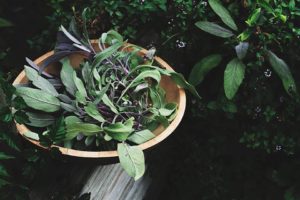If you walk into any New Age shop you will undoubtedly find a basket or bin of white sage bundles. You may find a few other items around it such as Palo Santo, Cedar bundles, Sweetgrass, but you will definitely find white sage. White sage has become the “go to” for cleansing/ clearing one’s person or space, or has it?
White Sage (Salvia apiana), is native to the Southwestern US, and Northern Mexico. It was used extensively by indigenous peoples for everything from food, medicine, body care (shampoos, oral care), as well as ceremonial uses. It is one of the four sacred plants represented in the medicine wheel on the West, (the other three are Sweetgrass for the North, Tobacco for the East, and Cedar for the South) [1].
Due to modern popularity it is now in danger due to over harvesting, and drought.[2] It is currently on the “watch” list of United Plant Savers. When using any plant, we want to be sure that this use is sustainable so that we are not contributing to the problem. Know your sources for your herbs, and plants. Better yet, plant some yourself if it can grow in your climate. And if it doesn’t grow in your climate ask yourself the serious question of “why I need to use this particular plant?” Our ancestors used plants that were native to their location. Get to know what plants are native to your location and cultivate a relationship with them.
There is an extensive list of plants that can be used for cleansing aside from White Sage.
*Desert Sage
*Cedar
*Mugwort
*Juniper
*Sweetgrass
*Frankincense
*Copal
*Palo Santo
are just a handful of substitutes.
When using plants for spiritual cleansing you are connecting not only with the plant, but with the great mother earth. In using plants sustainably, respectfully, and with gratitude we tread lightly on the earth. I can think of few things more spiritual in nature then that.
[1] https://www.mountainroseherbs.com/products/white-sage-cultivated/profile
[2] https://www.unitedplantsavers.org/species-at-risk
Green blessings,
Ali

* The information presented in this article is for educational purposes only, and should not be interpreted as a substitute for diagnosis and treatment by a health care professional.
© Ali Wolf –20018
